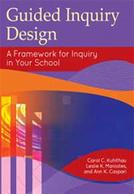 In addition to advocating for learning experiences that involve stimulating students’ creativity, engaging them in experimentation, and activating their creativity (see last week’s blog post), coplanning and coteaching inquiry learning are also ways to increase students’ opportunities for diverse final products. If our message to students is that all roads lead to the same outcome, many will not see the relevance of their learning experiences to their lives. They will not experience learning as a complex activity that results in diverse creative expressions of learning. Too many will disengage or simply be lost or derailed along the way.
In addition to advocating for learning experiences that involve stimulating students’ creativity, engaging them in experimentation, and activating their creativity (see last week’s blog post), coplanning and coteaching inquiry learning are also ways to increase students’ opportunities for diverse final products. If our message to students is that all roads lead to the same outcome, many will not see the relevance of their learning experiences to their lives. They will not experience learning as a complex activity that results in diverse creative expressions of learning. Too many will disengage or simply be lost or derailed along the way.
Supporting Classroom Teachers and Specialists
During coplanning, classroom teachers and specialists may express reservations about students taking curriculum into individual or unexpected pathways. Secondary educators, in particular, who may be responsible for learning outcomes for 75 middle school or as many as 150 high school students may shudder to think that they alone will be responsible for guiding and assessing students’ learning.
School librarians who coplan, coimplement, AND coassess student learning outcomes can ease classroom teachers’ and specialists’ concerns about giving students “free rein” to explore in many different directions and in producing many different final products. Collaboration can also ensure that educators create flexible assessment tools that accurately reflect students’ achievement in terms of learning objectives as well as their creativity.
Supporting Students
Two (or more) educators working as a team can better monitor and guide individual student’s learning as well as small group work. Inquiry circles as described in the guided inquiry require check-ins from educators (Kuhlthau, Maniotes, and Caspari 2015, 32–36). It is through check-ins that educators push students’ thinking, offer resource support, identify stumbling blocks, and opportunities for reteaching specific subskills to the students who need them to move forward.
One of my all-time favorite teaching memories involved working with a second-grade teacher (in the late 1990s) who structured her classroom around inquiry. Students identified areas of interest, pitched their ideas to the class, and formed small groups to pursue meaningful questions. As their school librarian, I often worked with more or more groups as they sought information through the library’s resources.
One of the questions for the “frog and other amphibians” group was about dissecting frogs to learn more about their body parts and functions. I helped the group contact a biology professor at the University of Arizona. The students posed their questions to him and organized a field trip to his lab where he led them in dissecting and learning about frogs. I had the distinct pleasure of accompanying them on their adventure. Years later, two students from that group remembered that learning experience as one of the most powerful in their elementary education.
The Underlying Message
Learning is complex and expressions of knowledge can (and should?) be unique. When classmates share their learning processes and final products, students (and educators) should be amazed at the divergent thinking and variety of expressions of learning. When students are given the opportunity to pursue learning that is personally meaningful, use resources they have discovered on their own, selected and employed tools that helped them meet their individual (or their group’s) goals for sharing, they are enacting the skills and dispositions of lifelong learners.
Inquiry Learning = Preparation for Life!
Questions for Discussion and Reflection
- What strategies have you used for supporting students’ diverse creative expressions of their learning?
- Describe the assessment tools you have used to guide students’ learning while giving them opportunities to express their learning in diverse and creative ways?
Work Cited
Kuhlthau, Carol C., Leslie K. Maniotes, and Ann K. Caspari. 2015. Guided Inquiry: Learning in the 21st Century. 2nd ed. Santa Barbara, CA: Libraries Unlimited.










